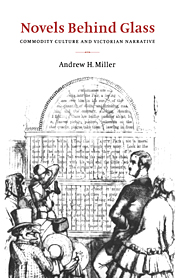Book contents
- Frontmatter
- Contents
- List of illustrations
- Acknowledgements
- Introduction
- 1 Longing for sleeve buttons
- 2 Spaces of exchange: interpreting the Great Exhibition of 1851
- 3 The fragments and small opportunities of Cranford
- 4 Rearranging the furniture of Our Mutual Friend
- 5 Owning up: possessive individualism in Trollope's Autobiography and The Eustace Diamonds
- 6 Middlemarch and the solicitudes of material culture
- Afterword
- Works cited
- Index
4 - Rearranging the furniture of Our Mutual Friend
Published online by Cambridge University Press: 17 August 2009
- Frontmatter
- Contents
- List of illustrations
- Acknowledgements
- Introduction
- 1 Longing for sleeve buttons
- 2 Spaces of exchange: interpreting the Great Exhibition of 1851
- 3 The fragments and small opportunities of Cranford
- 4 Rearranging the furniture of Our Mutual Friend
- 5 Owning up: possessive individualism in Trollope's Autobiography and The Eustace Diamonds
- 6 Middlemarch and the solicitudes of material culture
- Afterword
- Works cited
- Index
Summary
“Keep things in their places,” Charles Dickens wrote to his wife, Catherine; “I can't bear to picture them otherwise.” The quotidian world of the Dickens household appears to have progressed on principles opposed to those characterizing Cranford. Instead of communal practices and everyday characters, the life of the Dickens household seems to have been dominated largely by Charles' solitary will. “If it is the property of a domestic nature to be personally interested in every detail,” writes John Forster,
the smallest as the greatest, of the four walls within which one lives, then no man had it so essentially as Dickens, no man was so inclined naturally to derive his happiness from home concerns. Even the kind of interest in a house which is commonly confined to women, he was full of. Not to speak of changes of importance, there was not an additional hook put up wherever he inhabited, without his knowledge, or otherwise than as part of some small ingenuity of his own. Nothing was too minute for his personal superintendence.
Forster's phrase, “even the kind of interest in a house which is commonly confined to women, he was full of,” seen along with Dickens' injunction to his wife, supports the idea that the routines of the Dickens household proceeded according to Charles' dictates rather than Catherine's. This was not transgressive gender-bending – none of Peter Jenkyns' hoaxing here; Dickens mans this home like a fort. For Catherine to have managed their home, she would have had to manage Charles as well, to collaborate with his “domestic nature,” and to check with him before placing new hooks on the wall.
- Type
- Chapter
- Information
- Novels behind GlassCommodity Culture and Victorian Narrative, pp. 119 - 158Publisher: Cambridge University PressPrint publication year: 1995



